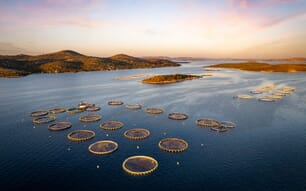In 2008 the Ministry of Agriculture and Lands (BCMAL) completed 119 salmon farm audits and collected diagnostic samples for disease analysis from 588 fish that had recently died.
All farms categorise their dead fish, giving probable explanation for the cause of death. About 25 per cent of the routine fish mortality are “silvers”. Silvers are fresh carcases that still have silver skin/scales and died most recently. These carcasses are used as indicators of active disease in the robust living population. Roughly 10 per cent of the silver group is selected and tested by BCMAL for cause of death and specific infectious diseases.
For Atlantic salmon, 80 per cent of the audit cases found ‘no infectious disease’ (at the farm-level). Of the infectious disease cases, the main diagnoses were mouth myxobacteriosis (11 per cent) and bacterial kidney disease (four per cent). For farmed Pacific salmon, 50 per cent of the audits cases found ‘no infectious disease’ (at the farm-level), and the main disease diagnoses were bacterial kidney disease (45 per cent) and vibriosis (five per cent). All of these diseases are endemic in wild salmon in British Columbia and it is expected that these diseases would also occur in farmed fish.
The Fish Health Audit and Surveillance Programme found the same endemic diseases as those reported by industry. The Ministry surveillance program detected no pathogens in farmed salmon that would affect the trade or export from BC or Canada.
Audits of sea lice abundance at Atlantic salmon farms confirm that the aquaculture industry is complying with the sea lice management strategy.
In 2008, BCMAL conducted lice counts at 71 farms and assessed over 4,200 live fish. Both the ‘salmon louse’ and the ‘herring louse’ can parasitize host salmon so a lice abundance trigger, established to guide the management of the salmon louse, was introduced and fully implemented in 2004.
To date, use of a trigger level of three salmon lice per farmed fish continues to be precautionary for lice management in BC; the lice abundance in farmed and wild salmon has declined since 2004. Further recent genetic research supports the current lice management strategy. This research offers a plausible explanation as to why Atlantic salmon raised in British Columbia show little or no outward signs of ill health from salmon lice of the Pacific Ocean strain.
The Ministry’s Fish Health Programme facilitates a comprehensive understanding of the health status of fish stocks on salmon farms. The programme supports the monitoring, reporting, and governance of fish disease, and addresses health concerns that may arise in farmed fish. This annual Fish Health Report summarises the information generated by the audit and surveillance portion of the provincial fish health programme for one calendar year.
2008 Aquaculture And Fish Health Reports
CANADA - The British Columbian government has released its 2008 Fish Health Report and Aquaculture Inspection Report.

